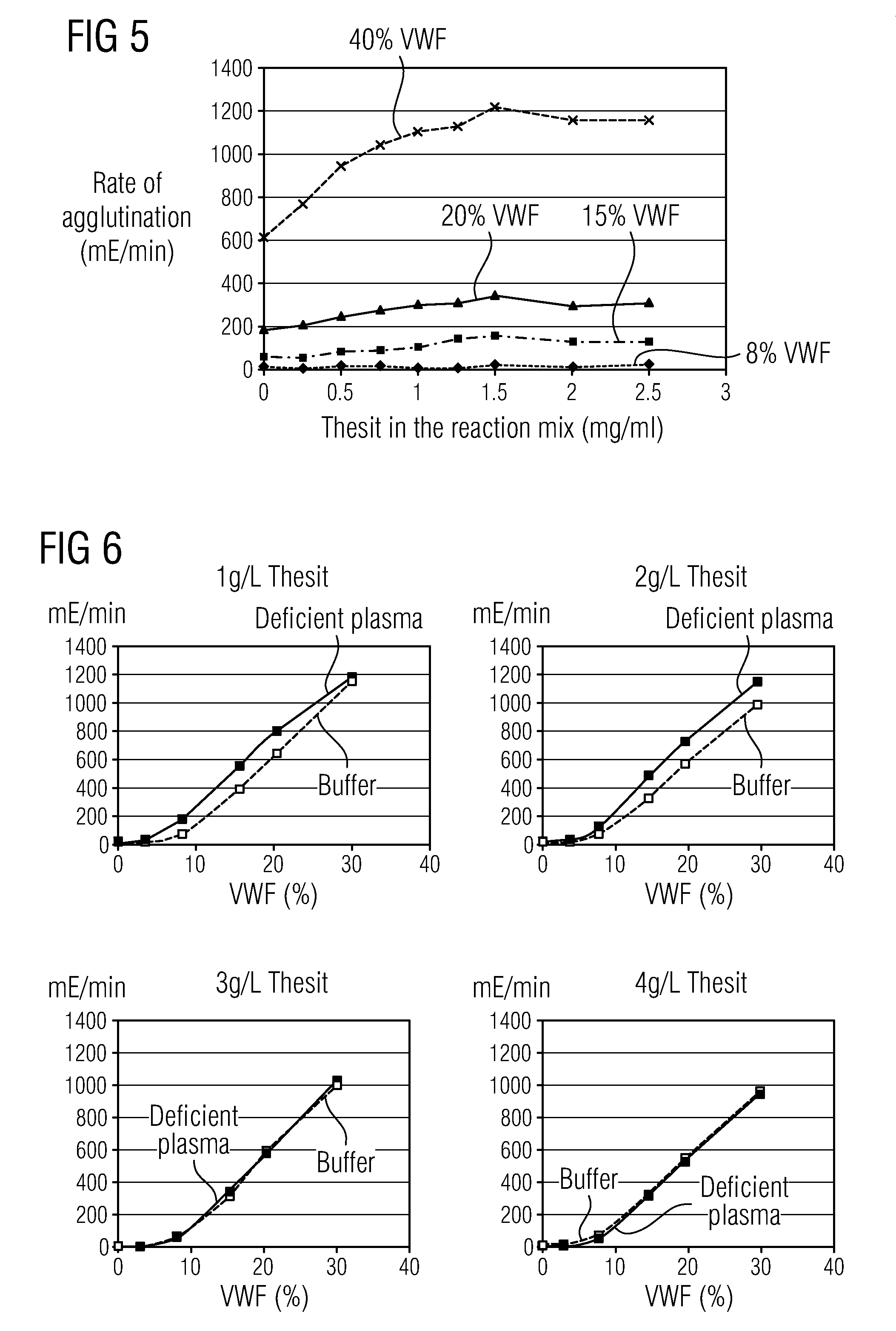Methods and Kits for Determining von Willebrand Factor Activity in the Absence of Ristocetin and for Determining the Activity of ADAMTS-13 Protease
a protease and von willebrand factor technology, applied in the field of coagulation diagnosis, can solve the problems of relative imprecision of assays, difficult automation, and accumulation of latex
- Summary
- Abstract
- Description
- Claims
- Application Information
AI Technical Summary
Benefits of technology
Problems solved by technology
Method used
Image
Examples
example 1
Cloning of the GPlbα-(G233V / M239V)-(3×Flag)-(6×His) (SEQ ID NO: 24) Construct
[0061]The pIRES neo2 expression vector (BD Biosciences, Clontech, Art. No.: 6938-1) was modified so as to include a 3×Flag tag and a 6×His tag between the EcoRI and NotI restriction cleavage sites. A fragment coding for the signal peptide (SEQ ID NO: 7) and the amino acids 1-285 of the human GPlbα receptor (SEQ ID NO: 1) and containing a valine-encoding codon at the sites coding for amino acid positions 233 and 239 was inserted upstream (5′) of the tag sequences.
example 2
Expression of the Recombinant GPlbα-(G233V / M239V)-3×Flag)-(6×His) (SEQ ID NO: 24) Fusion Protein in HEK Cells
[0062]HEK 293 cells (human embryonic kidney cells; ATCC number; CRL-1573; Cell Lines Service CLS, Heidelberg, Germany) were transformed with the construct described in Example 1.
[0063]The cells were cultured in:[0064]DMEM (Art. No.: 31966-021, Invitrogen)[0065]+10% FBS Origin EU (Art. No.: 10270-106, Invitrogen), heat-inactivated or else in 10% FBS Origin USA (Art. No.: A15-003, Lot No.: A01123-678, PAA)[0066]+1% Antibiotic Antimycotic Solution (100×) (Art. No.: P11-002, PAA)[0067]+0.1% Gentamycin Solution 50 mg / ml (Art. No.: P11-005, PAA)[0068]+500 μg / ml Geneticin (G418) Solution 50 mg / ml active Geneticin (Art. No. 10131-027, Invitrogen)
[0069]For the expression (production):[0070]OPTIPRO-SFM (Art. No.: 12309-019, Invitrogen)[0071]+0.5% Antibiotic Antimycotic Solution (100×) (Art. No.: P11-002, PAA)[0072]+0.05% Gentamycin Solution 50 mg / ml (Art. No.: P11-005, PAA)[0073]+2% Gl...
example 3
Isolation of the Recombinant GPlbα-(G233V / M239V)-(3×Flag)-(6×His) (SEQ ID NO: 24) Fusion Protein by Affinity Chromatography.
[0083]The cells or cell debris still remaining in the GPlbα-(G233V / M239V)-3×Flag)-(6×His)-containing medium obtained according to Example 2 were removed by centrifugation (35 min, 10 000 rpm, Beckman J2-21, Beckman Coulter GmbH, Germany). The cell-free supernatant thus obtained was concentrated to 1 / 10 of the starting volume by means of tangential flow ultrafiltration using an ultrafiltration cassette with a cut-off of 10 kDa (PES 10, Schleicher & Schüll, Germany).
[0084]The purification was carried out by means of affinity chromatography using Ni2+-Sepharose (His Prep FF16 / 10, GE Healthcare, Sweden) according to the manufacturer's instructions. GPlbα-(G233V / M239V)-(3×Flag)-(6×His) was bound by adding to the concentrated supernatant 500 mmol of NaCl, 20 mmol of Na2HPO4 and 5 mM imidazole and adjusting the pH to pH 7.4 by adding 5M HCl. Unbound components were wa...
PUM
| Property | Measurement | Unit |
|---|---|---|
| concentration | aaaaa | aaaaa |
| apparent molecular mass | aaaaa | aaaaa |
| apparent molecular mass | aaaaa | aaaaa |
Abstract
Description
Claims
Application Information
 Login to View More
Login to View More - R&D
- Intellectual Property
- Life Sciences
- Materials
- Tech Scout
- Unparalleled Data Quality
- Higher Quality Content
- 60% Fewer Hallucinations
Browse by: Latest US Patents, China's latest patents, Technical Efficacy Thesaurus, Application Domain, Technology Topic, Popular Technical Reports.
© 2025 PatSnap. All rights reserved.Legal|Privacy policy|Modern Slavery Act Transparency Statement|Sitemap|About US| Contact US: help@patsnap.com



